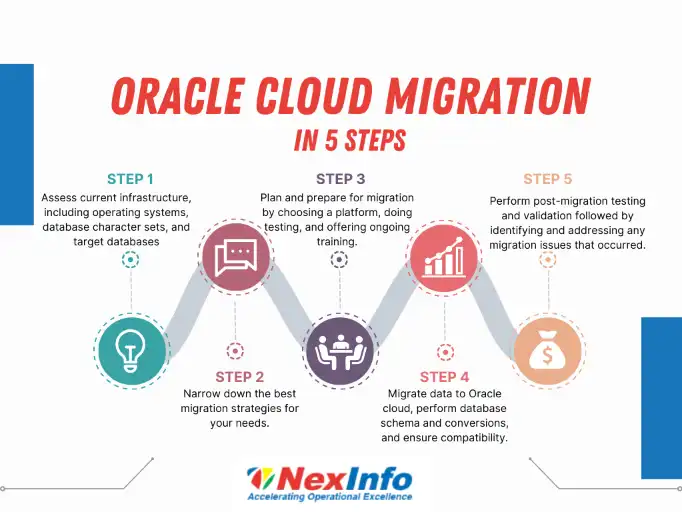Following the right Oracle cloud migration steps is critical for a successful deployment. With the rise of cloud computing, more and more businesses are moving to the cloud to reap the benefits it provides, including improved flexibility, scalability, and data security.
When you move your ERP system into the cloud, it means that the ERP software and associated data are stored on the internet. They are operated from the cloud and accessed over the internet, rather than from an on-premise solution.
Over the years, Oracle migration to cloud infrastructure has become a popular option for businesses looking into cloud-based ERP systems. This is because of the Oracle Cloud’s advanced data management features, customizable modules, and machine learning capabilities.
Successful Oracle cloud ERP implementation projects require careful planning and execution, whether migrating or setting it up. This article lays out the 5 main steps of Oracle ERP cloud migration and the benefits of doing so.
5 Steps for a Successful Oracle Cloud Migrations
1. Assess Your Current Infrastructure
Before you migrate to Oracle cloud, assess your current infrastructure. This initial assessment will help you identify any potential issues that could arise during the migration process.
During cloud assessments, review your:
- Operating system
- database character set
- Target databases
2. Choose the Right Migration Strategy
Make sure you choose a migration strategy based on your needs and requirements. Cloud solutions are not one-size-fits-all. For example, you will need a different strategy if you’re migrating from on-prem to cloud than you would if you were migrating from AWS to Oracle.
By choosing the right migration strategy and leveraging expert Oracle migrations service, you can minimize downtime and reduce the risk of data loss.
3. Plan and Prepare for Migration
Planning and preparation are key to a successful migration. This step includes selecting the right cloud platform, testing the migration process, and ensuring that your team is fully acceptant of and trained on the new system.

Additionally, you’ll need to consider other factors like data security, user experience, and total cost of ownership. You may hire skilled ERP consultants to help you streamline the process and answer questions.
4. Migrate Data to Oracle Cloud
After proper planning and preparation, you can migrate your data securely and efficiently to Oracle Cloud.
You may also need to perform database schema and data conversions to ensure compatibility with the new system. You can use Oracle’s integrated migration tools or support from a trusted Oracle Platinum Partner to simplify this process.
5. Post-Migration Testing and Validation
After the migration process is complete, perform post-migration testing to ensure data accuracy and proper system functionality..
This step can help identify any potential issues and ensure that the migration was successful. You should also have ongoing support post-migration to help remediate later issues as they arise.
- Oracle EPM Cloud
- Moving to Oracle Cloud HCM: Quick Guide
- What Do You Need to Know About Oracle Cloud
Map Out Your Oracle Cloud Migration Steps with NexInfo
There are a lot of good reasons to migrate.
Benefits of migrating to Oracle Cloud include:
- Increased accessibility and availability of data
- Access to advanced analytics and reporting capabilities
- Improved data security and disaster recovery capabilities
- Seamless integration with other cloud-based tools and services
- Significantly reduced the cost of ownership compared to on-premise
- Reduced costs associated with infrastructure maintenance and upgrades
- Automating mundane business processes
However, a successful Oracle Cloud migration involves careful planning, customization, data migration, testing, and validation.
These Oracle cloud migration steps will help, but you can further streamline your project with NexInfo.
We’ll show you how to utilize cloud technology, machine learning digital assistants, and Oracle’s integrated yet modular architecture.
Contact us to learn more.








